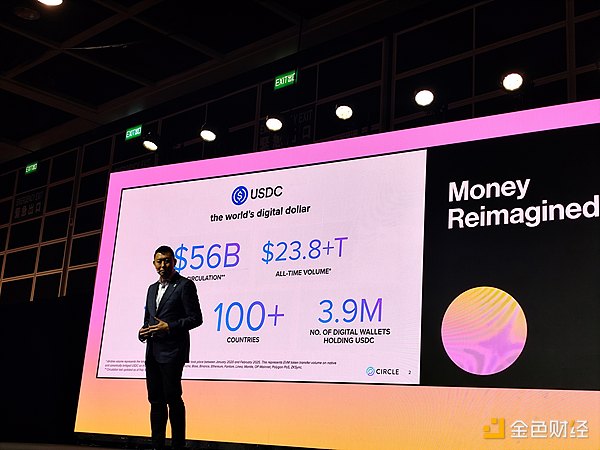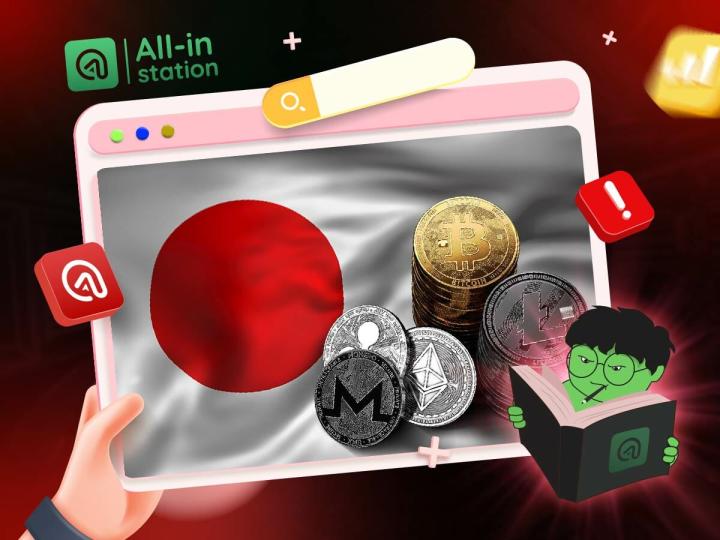Summary: Jinse Finance
On February 19, at the Consensus HK 2025 conference, Yam Ki Chan, Vice President of Cooperation and Business for Circle Asia-Pacific, gave a speech titled "USDC as a Platform for Global Prosperity".
Jinse Finance has summarized the content of the speech for readers.

Yam Ki Chan, Vice President of Cooperation and Business for Circle Asia-Pacific
It's great to see everyone. As someone born in Hong Kong, it's always a pleasure to be back in Hong Kong. I also want to applaud CoinDesk's Consensus conference for bringing industry leaders together and fostering a spirit of consensus. This is a fantastic event.
What future lies behind the $56 billion market cap of USDC?
First, I want to announce that the market cap of USDC has reached $56 billion! This was the historical high about a week ago. It seems everyone is talking about this. But what lies behind this $56 billion high?
There are now over $23 trillion in on-chain transactions processed through USDC, which is different from the situation before 2023. Currently, the USDC blockchain is also more extensive than ever before. USDC is being used in over 100 countries globally. There are nearly 4 million wallets actually holding and using USDC globally. But to build a true stablecoin business, there are many other aspects involved, which is something our team is constantly thinking about.
So what has made the $56 billion possible?
USDC is the digital US dollar on the internet, and it has two noteworthy advantages: First is the stability of USDC. USDC is the world's largest regulated US dollar stablecoin, regulated in the US, Singapore, Europe, and backed 1:1 by reserves, providing the necessary trust for users. The second is settlement efficiency. USDC has the ability to settle US dollars almost instantly, with very low transaction costs. The combination of these two factors is what makes USDC unique.
Currently, we are also building payment protocols for the internet. This is not limited to USDC, but involves the broader stablecoin landscape. Additionally, many people have asked me why Circle doesn't issue a Hong Kong dollar stablecoin or stablecoins for other currencies? Now, we believe the world will ultimately move in this direction. We are focused on the largest, regulated US dollar stablecoin, and we have also issued the euro stablecoin EURC, and we hope to see more stablecoins for different currencies around the world in the future. This is the future of stablecoins.
The three main use cases of stablecoins
Many people ask, what are the use cases of stablecoins? I will categorize them into three.
First, around digital assets and capital markets. Second, around consumer payment solutions. Third, around cross-border payments.
In the digital asset and capital markets, whether traders, market makers, or others who need to enter and exit positions, whether it's BTC or other cryptocurrencies, they need real-time settlement of some transactions. We have partnered with many giants in the financial sector to allow them to use USDC, helping them and their partners to settle through USDC.
In consumer payments, companies like HKT, Mastercard, Visa are using Web3 solutions for digital transformation and entering the next stage of financing. They are all using USDC for settlement, and we are also pleased to see many companies in emerging markets, including Grab, using Web3-related services or using USDC as a way to provide dollar savings and dollar holding for their users. Recently, we also announced a partnership with Lulu in the Middle East, and we look forward to working with them. In the current cases, it is more telecommunications companies and internet companies that are upgrading their services on the blockchain. We are helping large companies transition from the traditional finance dimension to the blockchain dimension, and providing them with some technical services. How to build, how to complete the transformation, how to view compliance issues? How to handle travel rules? These are all very important topics.
In cross-border payments, cross-border payments may be the most exciting aspect of stablecoins. We have partnered with MoneyGram, Stellar, and UNHCR (United Nations High Commissioner for Refugees) to provide aid dollars to Ukrainian refugees experiencing war. These refugees can receive funds directly from the United Nations and be able to send and use this money on Stella's network. Last October, we announced a partnership with Tunes, which moves money for many remittance companies and payment companies around the world. How to use USDC and Stable Points to achieve faster commerce and faster payments is a very transformative issue.
The bright prospect of regulation will rewrite the way of cross-border payments
In the past few months, it would not have been possible to discuss regulatory issues without the shift in the US regulatory attitude, and now there are clear regulatory bills on stablecoins in Congress.
If Trump's promise is fulfilled, a regulatory standard will be released within his first 100 days in office. Currently, US regulation is lagging behind. For example, other jurisdictions like Europe have already enacted regulations. The EU's MICA law will take effect on July 1, 2024. And Circle has become the first global stablecoin issuer to comply with the MICA law, allowing it to issue USDC and euro stablecoins within that framework.
We have announced the establishment of an office in Abu Dhabi, Middle East. Additionally, Japan also has regulations on stablecoins, and the FSA has actually issued guidelines for well-regulated stablecoins. Hong Kong is also working to introduce industry legislation, which has similarities to the frameworks in the US, Japan, and Europe.
How to regulate stablecoins, what kind of stablecoins will be regulated in different jurisdictions, are all issues that need to be coordinated. The stablecoin market has just begun, and as regulation improves, as more companies create their networks, wallets, and platforms, we will see more settlement transactions happening on-chain in the future.
Small, medium, and large companies will hold Treasuries on-chain through stablecoins, and they will be able to invest through stablecoins when needed. As regulatory frameworks become clearer, more and more partners will join this effort. We will rewrite the way of cross-border payments.
I'm very excited about the work of artificial intelligence, so I can't help but mention it. The really interesting thing about AI is that these AI agents are getting smarter and smarter every day. For AI agents, sending an email to accounts payable to make a bank payment is incredibly stupid, they will likely settle on-chain through stablecoins. So I'm super excited about what's to come.
I'm very honored to be a participant in this summit. Thank you very much.







